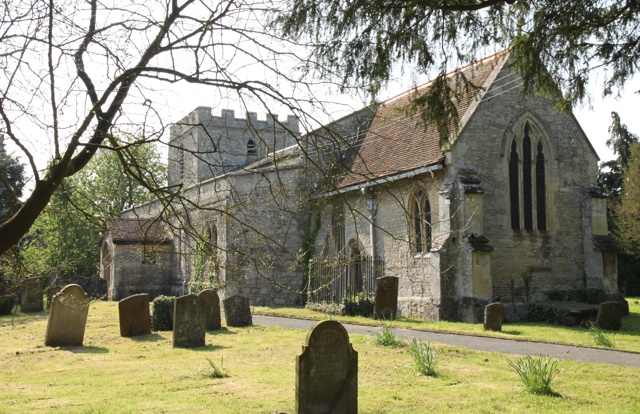


























St Nicholas Church, Piddington
St. Nicholas Church in Piddington comprises a chancel, nave, south aisle, and low embattled west tower. The well-proportioned chancel dates from about 1300, and has four windows of the same period with cusped rear arches. There is a three-light east window of graceful and slender proportions. Two sedilia of about the same date are richly foliated, the third section having been converted into a priest's door. The workmanship, in elaborate contrast to the simplicity of the chancel itself, resembles that of the piscina and the recess on the north side of the chancel. The latter has Purbeck marble pillars and is ornamented with figures of angels. The south doorway dates from the 14th century, and the nave from the late 13th with 15th-century windows. The wall-painting of St. Christopher on the north wall opposite the door was discovered in 1896 beneath a 17th-century Creed; it was completely uncovered and restored in 1935 by E. T. Long of Oxford. Its faint outlines reveal the saint with his staff, and a hermit's chapel (perhaps that at Muswell) in the background. The tower dates from the 16th century, but its doorway was blocked up in 1826. Two texts inscribed on the walls near the belfry entrance are dated 1665. The painting of other texts is recorded in 1784, when the Commandments, the Apostles' Creed, and the Lord's Prayer were executed. In 1730 a communion table and rails were fetched from Bicester. In 1826 extensive repairs were undertaken, including a new roof, costing £237; and in 1855 the interior of the church was completely restored for £554. There had been a musicians' gallery on the north side and a southern gallery, set up in 1813, which were removed, whereby 'the beautiful solid western arch' was thrown open and the belfry used for additional seats. At the same time 'the irregular horsebox pews' were replaced by 'low and open seats conducing to vigilance, propriety and decorum'. The pulpit, installed in 1828 and made by the carpenter William Parrott, was also moved at this date. Restoration undertaken by J. O. Scott was completed in 1898; a new chancel arch was built and the chancel ceiling reconstructed in panelled oak; the nave was restored externally, the foundations underpinned, and a new ceiling inserted. An entirely new roof to the south aisle was built and the exterior repaired. The stonework of the tower up to the plinth was also restored. Extensive internal repairs to the whole church were carried out, including the installation of heating apparatus. A memorial window of stained glass to the Revd. Charles Hill was designed by Jones & Willis (London). The monuments inside the church include a black marble tablet in the north wall of the chancel to Elizabeth (d. 1709), wife of John Walker; a tablet to John Walker (d. 1722), 'a pious son of the Church of England'; a monument to John Walker (d. 1731) and his relations; a brass (1613) to Catherine Hussey. In the churchyard, which was newly railed in in 1843, is the grave of John Drinkwater, the poet (d. 1937). The Edwardian inventories mention altar cloths (one of diaper, six of 'Ollande clothe'), vestments and surplices, a box of ivory inside the pyx, having 'small glasyes of sylver upon hit', and two chalices of silver gilt. The pre-Reformation chalices have gone (one by 1553), and the church plate now includes an Elizabethan chalice (1580) inscribed with a 'P', and silver plate given by William Ward of Piddington in 1640. The silver chalice with paten and cover, given by Jane White of Piddington in 1683 and inscribed accordingly, which were part of the church property in 1928 have since vanished. In 1553 there were three small bells, a sanctus, and a hand-bell. The second bell was recast in 1705, and the tenor cast by Hemins of Bicester in 1729, the fourth bell being run by the same firm in 1738. In 1887 the third was recast, and a treble and second provided by Mrs. Brown of Manor Farm. The registers begin in 1653. A chest with three locks and keys was kept in the church in 1634; a new iron chest was bought in 1813. Historical information about St Nicholas Church is provided by 'Parishes: Piddington', in A History of the County of Oxford: Volume 5, Bullingdon Hundred, ed. Mary D Lobel (London, 1957), pp. 249-258. British History Online http://www.british-history.ac.uk/vch/oxon/vol5/pp249-258 [accessed 20 February 2023]. St Nicholas Church is a Grade II* listed building. For more information about the listing see CHURCH OF ST NICHOLAS, Piddington - 1233014 | Historic England. For more information about St. Nicholas Church see Parishes: Piddington | British History Online (british-history.ac.uk). |

